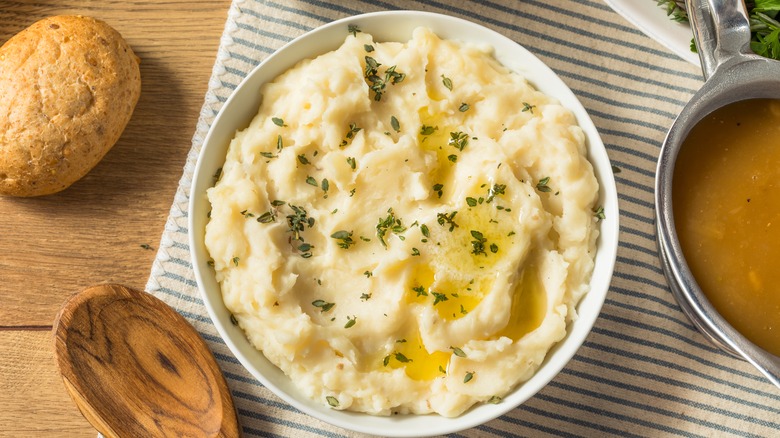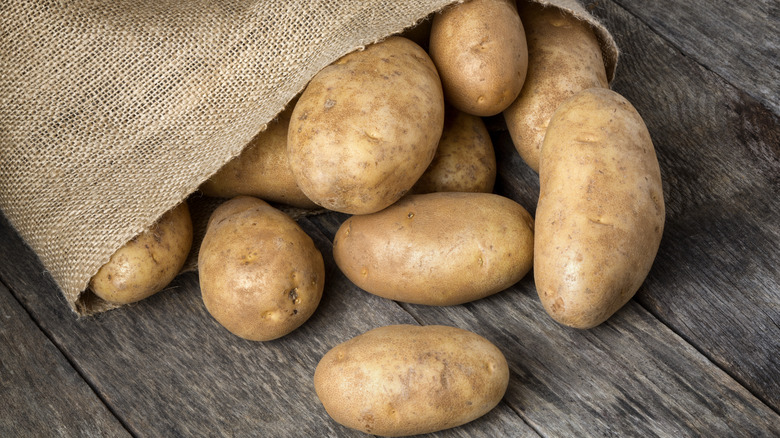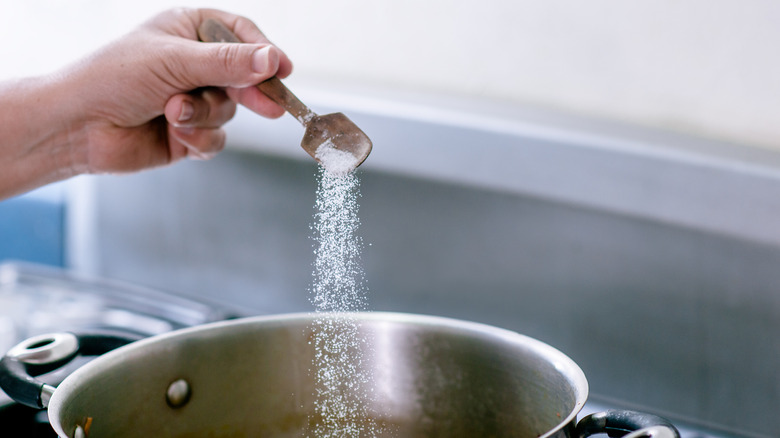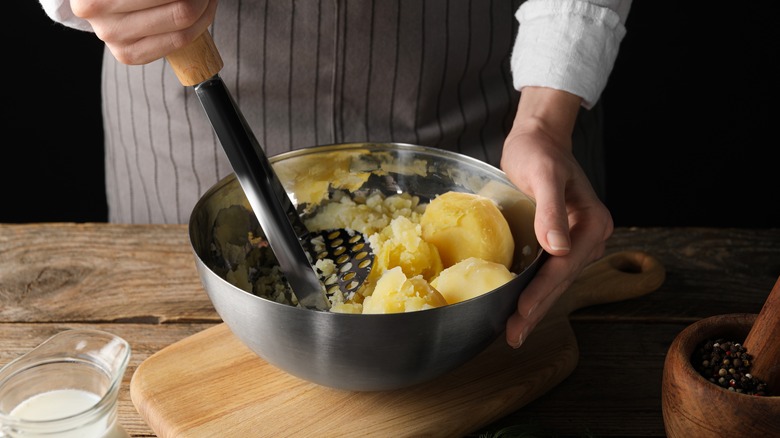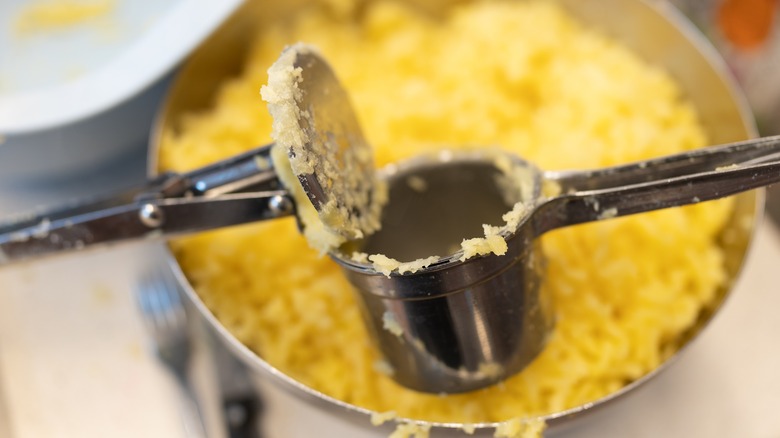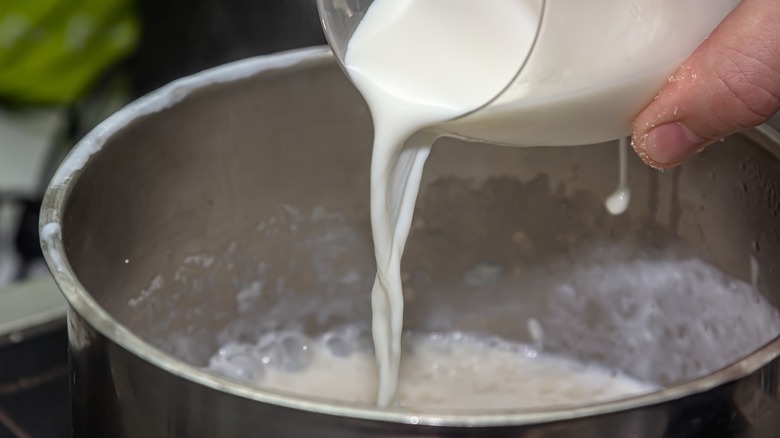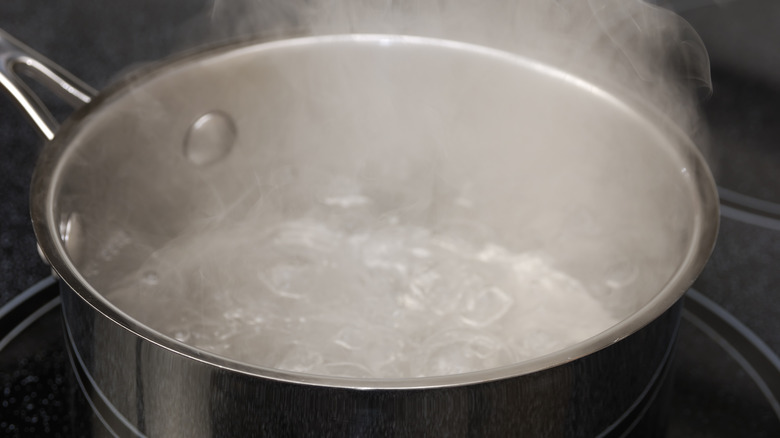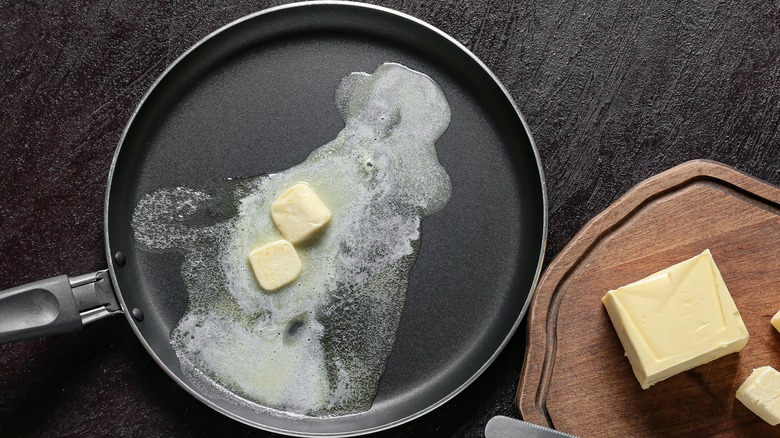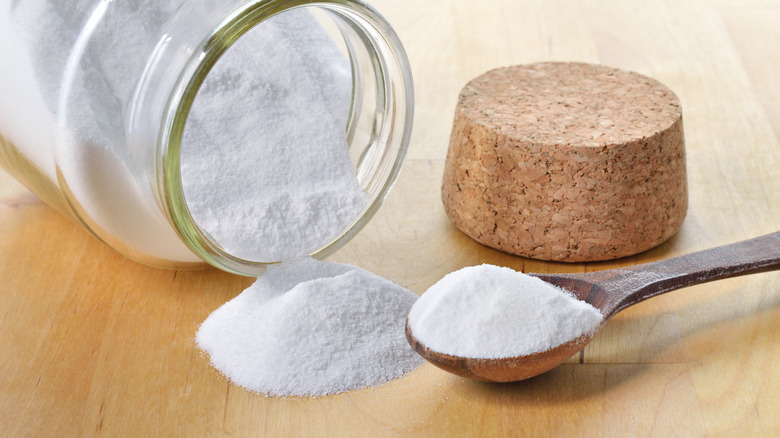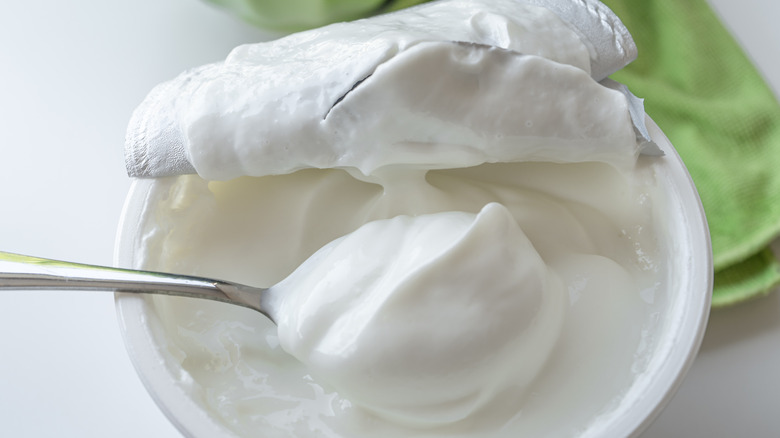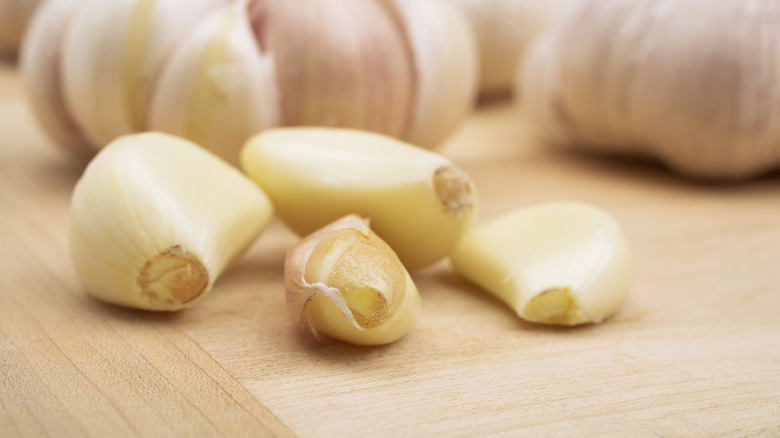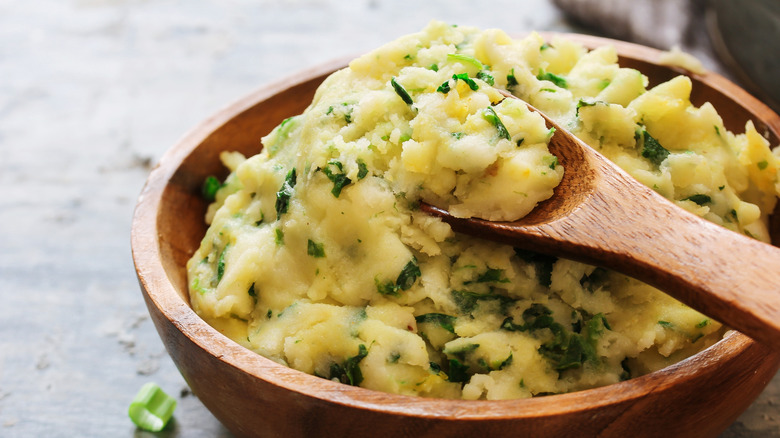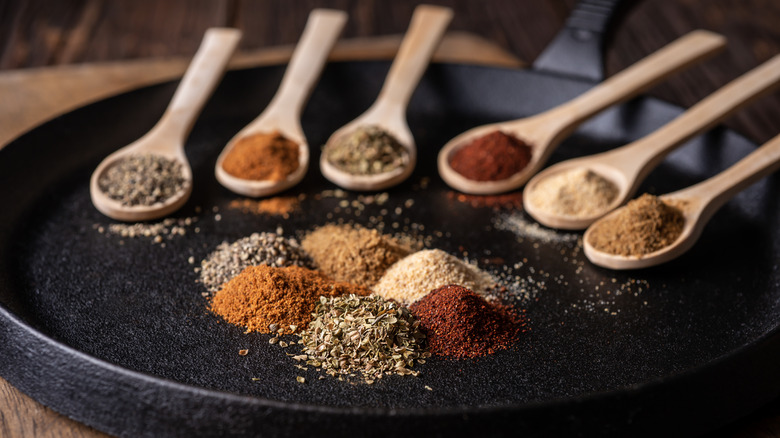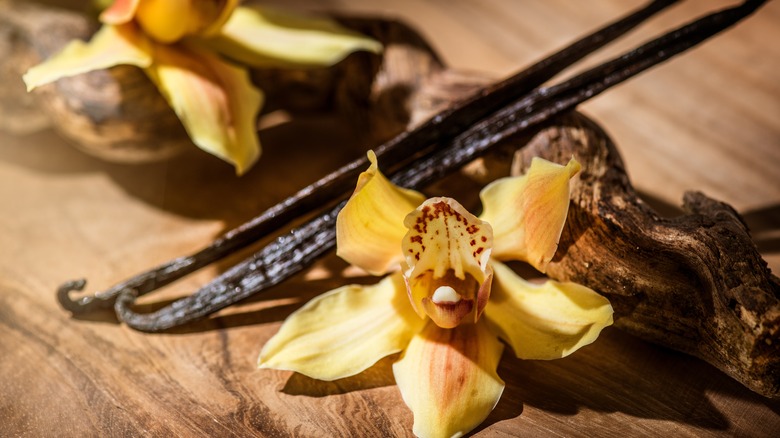13 Secrets To Make Your Mashed Potatoes Taste Even Better
From holiday dinners to Sunday roasts, a mound of mashed potatoes is a quintessential component of so many favorite meals. Whether you love them smothered in gravy or doused in hot sauce, a fluffy bowl of smashed spuds is hard to turn down. What could be better than spoonful after spoonful of potatoes mixed with butter and salt? As simple as this familiar food sounds, mashed potatoes are a tricky dish to master for many home cooks. If you've ever attempted to choke down a gluey forkful of bland mash at Thanksgiving or found yourself dumping a shaker's worth of salt on a grainy bowl of potatoes, you know that no mashed potato recipe is foolproof. Mastering the art of this starchy side dish requires a balance of carefully selected ingredients, the right cooking methods, and sometimes a bit of creative touch.
These secrets come from years of trial and error, sampling different combinations of ingredients, tools, and mashing methods, all in the name of potato perfection. Whether you're craving a traditional take on the classic comfort food or something with a spicier flate, these tips and tricks will help you transform your mashed potatoes from mundane to magnificent.
1. Start with starchier potatoes
All the cooking hacks in the world are useless if you don't start with the right kind of potatoes. While you can technically boil and mash any kind of potato, only a few have the potential to transform into a fluffy bowl of mash. For potatoes with an airy, whipped consistency, choose varieties with a high starch content. Russet potatoes, with an average starch content of 21%, lend themselves especially well to mashing. All that starch expands during the boiling process which, paired with the right mashing techniques, creates fluffy mashed potato perfection.
Yukon Gold potatoes are another wonderful choice for mashed potatoes. While they have less starch than russets, their thin skin and naturally buttery flavor give mashed potatoes a mouthwatering balance of creaminess and fluffiness. It's best to avoid using waxy potatoes like red potatoes and baby potatoes in your favorite mashed potato recipe. These types of tubers are watery with a lower starch content. When mashed, they become gluey, mushy, and unappealing.
2. Amp up the flavor by adding salt to the cooking water
You might think salting after cooking is enough. But if you're not adding salt to your spuds right at the start of the process, your mashed potatoes will never reach their full flavor potential. Salt draws out the natural sweetness of potatoes as they boil, intensifying their earthy goodness to prevent them from tasting bland or bitter. The potatoes absorb that salty, briny quality into every nook and cranny as they cook so every bite of your mashed potatoes brims with savory, mouthwatering flavor. When you salt potatoes after cooking, it's challenging (if not downright impossible) to get the same consistency of saltiness throughout the entire dish. As a result, many home cooks end up overmixing their mashed potatoes as they add more salt — a common pitfall that can cause even the starchiest, fluffiest boiled potatoes to turn pasty.
So next time you set a pot of potatoes on the stove to boil, get that water nice and salty first. Your taste buds will thank you and all of your dinner guests will be begging to know what you did to turn a forgettable bowl of potatoes into such a memorable, showstopping side dish.
3. Mash the potatoes by hand
Electric mixers and beaters might be convenient, but they can lead to mushy, goopy potatoes. Instead, stick with old-fashioned hand mixing. Use a potato masher or strong fork to break up the boiled potatoes and smash out any lumps. This tried-and-true method takes a bit of elbow grease — especially if you demand smooth and lump-free potatoes — but the tradeoff is worth it to avoid overmixing. Whether you prefer ultra-velvety mashed potatoes or enjoy a more rustic texture, manual mixing gives you the ultimate control. Remember, you can always mash potatoes more, but it's hard to walk back the gummy side effects of potatoes mashed with too much vigor.
Along with giving you control over the consistency, manual mashing offers some serious potato flavor perks. Unlike high-powered electric mixers which quickly break down starch and liquidy potatoes, gentle hand mashing keeps the starches largely intact. The preserved starches lend a richer, more robust flavor to the familiar dinner side dish.
4. Use a potato ricer for extra fluffy mash
Every mashed potato enthusiast should have a potato ricer in their toolkit. Inexpensive and easy to use, this humble tool creates mashed potatoes that are silky smooth with more consistency and ease than traditional hand-held mashers. It works by gently pressing the softened chunks of potato through tiny perforations, eliminating pesky lumps to create creamy ribbons of mash. The potato ricer's delicate touch helps keep potatoes from releasing too much starch and becoming gooey. This translates into cloud-like mounds of mashed potato with a bright, buttery flavor that shines in every bite.
Love mashed potatoes but hate all the peeling involved? The potato ricer is about to become your new best friend. You can add cooked unpeeled potato chunks right to the ricer, flesh-side down. The ricer will coax the soft potato flesh away from the skin and into your mixing bowl. You will have to remove the peel from the ricer, but it's still less labor-intensive than peeling potatoes one by one.
5. Swap the milk for heavy cream
Have you ever wondered which liquid is best for making mashed potatoes? The answer depends somewhat on the flavor and texture you're after. Milk is the go-to liquid for many cooks for a good reason: it works well and has a neutral flavor that won't clash with other spices or mix-ins. But the richest, creamiest tasting potatoes contain — you guessed it — cream. Swapping out the standard milk for heavy cream in a mashed potato recipe is a foolproof way to add a touch of decadence to the humble dish.
With at least 36% milk fat content, heavy cream is the fattiest liquid milk product you'll find in the dairy aisle. It's that high fat content that makes heavy cream so ideal for mashed potatoes. When you mash potatoes with cream, the fats bind to the potato starches, coating every bite with a luxuriously creamy flavor and a silky mouthfeel. Mashed potatoes made with heavy cream will almost always taste richer and more decadent than the same recipe made with whole milk or even half-and-half. For that reason, make sure to check your carton label to ensure you're using real heavy cream. Regular or "light" whipping cream with a lower fat content won't deliver the same results as its fuller fat counterpart.
6. Ladle some cooking water into your mashing bowl
As potatoes boil, they release some of their starch into their water bath. Instead of wasting those good starches, you can save some of the cooking water to add to your mashed potatoes later. When the potatoes are finished cooking, set aside some of the briny water in a separate bowl before draining the potatoes. Then add a spoonful or two of the reserved water into the mashing bowl as you break up the potatoes. The cooking water adds starch back into the mashed potatoes for a fluffier texture while helping incorporate salt into every nook and cranny.
The amount of cooking water you need will depend on the amount of potatoes you're making. The quantity of other liquid ingredients like cream and butter also affects how much water you should use. Start with a tablespoon just to help loosen up the potatoes and begin the mashing process before adding the cream and butter. If the potatoes still look dry at the end of mashing and you're out of cream, you can add more water, a spoonful at a time until you reach the moisture level you want.
7. Brown your butter
Rich buttery flavor is a hallmark of good mashed potatoes. For an extra dose of luxury, try adding browned butter to mashed potatoes. The slightly nutty, caramelized flavor can transform an ordinary bowl of mash into a gourmet-quality side dish. The best part for busy home cooks is that browned butter mashed potatoes require very little extra work. Making brown butter involves melting butter in a skillet and swirling it over medium heat until golden brown. Once toasty and aromatic, you can mix it right into your mashed potatoes just as you would regular butter.
For an extra gourmet finishing touch, reserve some of the browned butter to add to homemade mashed potatoes right before serving. Use the back of a spoon to create an indent on the top of each mound of plated potatoes, then drizzle your golden brown butter into each one. You'll love the complex flavor and impressive presentation that pools of browned butter add to the familiar comfort food.
8. Add baking powder
The secret to sky-high clouds of mashed potatoes is tucked inside your baking cabinet. Baking powder, a leavening agent that gives lift and rise to baked goods, can create the same effect in a bowl full of fresh mashed potatoes. Made from a combination of sodium bicarbonate, powdered starch, and acids, baking powder releases carbon dioxide gas when exposed to heat. The gas expands in the starchy mashed potatoes giving them an otherwise unachievable airiness and fluffiness.
Baking powder is particularly useful when you're making rich mashed potatoes with heavy cream, lots of butter, and other fatty mix-ins like shredded cheese. While these ingredients add flavor and creaminess to a bowl of mash, they can also weigh down the potatoes. A teaspoon of baking powder balances out that extra weight so you get potatoes that look as fluffy as they taste. Work quickly to get the best effect from this cooking hack: The potatoes need to be steaming hot for the baking powder to work effectively.
9. Add tang with Greek yogurt or sour cream
Acidity is a secret weapon that's often overlooked when it comes to savory mashed potatoes. A little bit of tang delivered in the form of sour cream or Greek yogurt acts as a culinary counterpoint to the rich butter and cream. Creaminess, a hallmark of good mashed potatoes, craves the balance of a bright, tangy foil. The acidity in ingredients like Greek yogurt and sour cream cut through the richness much like a zesty lime in a guacamole. As a bonus, the acid also helps balance out any bitterness left by flecks of potato skins or baking powder.
Wondering which ingredient is superior? That's a matter of preference – both sour cream and plain Greek yogurt will add a pop of vibrancy to your potatoes. Sour cream contains more fat than Greek yogurt, which can help add richness and moisture (although if you're already using heavy cream and butter, that added fat might not be necessary). Greek yogurt has the nutritional perk of containing more protein and fewer overall calories and fat. Swirl a dollop of either one into your next mashed potatoes, and you'll immediately notice the upgrade in taste.
10. Incorporate garlic for depth and complexity
Garlic and potatoes are a match made in culinary heaven. Pungent aromatic garlic shines when paired with the neutral, starchiness of cooked potatoes. Even a touch of garlic can turn an otherwise lackluster potato dish into a gourmet delicacy. While adding garlic to mashed potatoes isn't a groundbreaking idea, there's a right and a wrong way to make good garlicky mashed potatoes. Too many cooks just mince a clove of raw garlic and toss it into the mash. If you've attempted this tactic before, you probably noticed the overwhelmingly bitter, sharp, or even metallic taste it left on your palate. That's because raw garlic contains a high concentration of allicins, the chemical responsible for garlic's signature fragrant flavor. When you cook garlic, either by roasting or sauteeing, those allicins break down creating a more muted, pleasing level of garlickiness.
To best infuse your mashed potatoes with garlicky flavor, cook your garlic cloves first. Roasted garlic is a popular and effective flavor enhancer for mashed potatoes thanks to its subtle sweetness and soft, butter consistency. You can also use chopped garlic that's been sauteed in a splash of extra virgin olive oil on the stove. In a pinch, even boiling peeled garlic cloves alongside the potatoes will do. Whichever method you choose, remember that fresh cooked garlic is always going to be superior to garlic powders, dried flakes, or garlic paste when it comes to flavor.
11. Add a pop of color and texture with fresh scallions
No one loves mashed potatoes for their beauty. Beige and shapeless, mashed potatoes run the risk of looking boring and unappetizing on a plate. This is particularly true if you're serving them with other brown and beige foods like roast chicken or turkey. Give your mash a beauty boost by tossing in a handful of fresh scallions or chives. A handful of either of these onion varieties adds visual appeal to an otherwise unphotogenic side dish. The crunchy, fresh texture is also a welcome complement to the softness and warmth of mashed potatoes.
Like garlic, scallions contain allicins, a flavor-packed compound with a mouthwatering aroma. Scallions have a less strong allicin flavor than garlic, meaning you can add them to the mashed potatoes without needing to cook them first. Chives taste even milder, making them a popular choice for topping potatoes that already have other strong flavors, like cheese and bacon, competing for top billing.
12. Turn up the heat with spices
Are your mashed potatoes tasting a little one-dimensional? Wake up your senses with a dash of spice. Think beyond the common sprinkle of black pepper and try adding crushed red pepper, ground cayenne, or cumin to your favorite recipe. Because potatoes have a neutral flavor by default, they pair well with a wide variety of spice blends. That's one of many reasons that potatoes are a staple for such a diversity of global cuisines. For inspiration, use other spicy potato recipes as a guide for seasoning your spuds. Recreate the fragrant spiciness of Indian samosas by tossing cumin, coriander, and turmeric into your plain mashed potatoes. If it's Tex-Mex food you crave, sprinkle a tablespoon of your favorite homemade taco seasoning over your potatoes before digging in.
To spice up your spuds without totally altering the flavor profile, a few small changes can go a long way. Try using freshly ground white or red peppercorns in place of the usual black, or adding a whisper of paprika to the bowl for a subtle spice boost that won't overwhelm your tastebuds.
13. Think outside the box with vanilla
Fragrant, complex, and powerful, vanilla's superpowers extend beyond the dessert world. These tiny pods harvested from dried vanilla beans work wonders in savory dishes when used correctly. Mashed potatoes are the prime example. Vanilla delicately brings out the natural sweetness of potatoes without making them taste cloying or noticeably sugary. Vanilla beans, scraped from the pod and crushed, can be added right to mashed potatoes with no extra prep needed. Vanilla bean paste, a packaged form of pulverized vanilla beans, makes an equally good substitute. Vanilla extract can also be used in mashed potatoes, but steer clear of imitation vanilla flavors which taste muted, artificial, and flat by comparison.
You only need a tiny bit of the crushed bean or paste to create mashed potatoes that stand out from the crowd. Start with a teaspoon, then taste a spoonful before adding more. You want the vanilla to enhance the creamy, buttery, and savory flavors of the potatoes, not dominate them.
